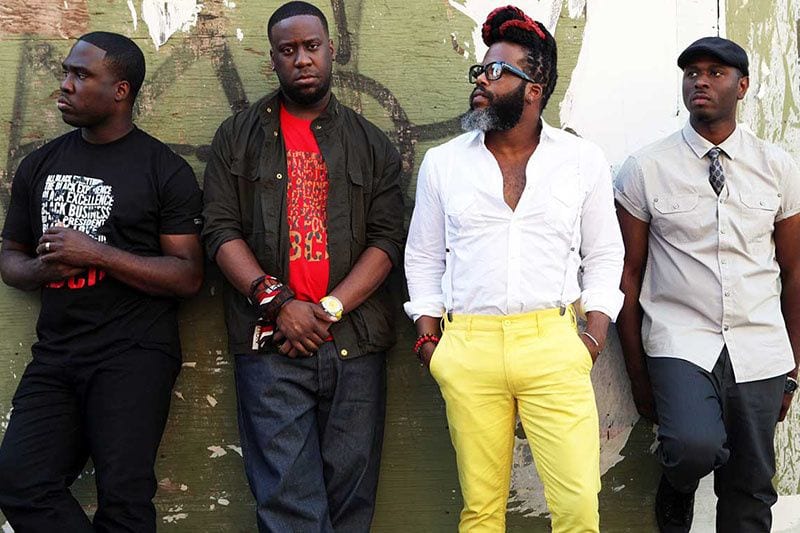
Jazz pianist Robert Glasper has been recording ever since 2002, but it was with the arrival of his two Black Radio albums where things really began to take off for him. He and his quartet, known as the Robert Glasper Experiment, have kept critics and fans busy with challenging albums such as Black Radio, Black Radio 2, and ArtScience. These four gentlemen genuinely don’t seem to care what you think of their blend of smooth piano jazz, high-energy electronics, processed vocals, intermittent use of hip-hop and samples, and plenty of other musical traits that don’t neatly fit into genre categories. In fact, any sour grapes directed towards them could probably be translated into a badge of pride, seeing as how one of hard bop’s tenets was to throw the listener for a loop or three.
The Robert Glasper Experiment have earned themselves a nice little victory lap in the form of a live DVD from Eagle Rock Entertainment simply titled Robert Glasper Experiment: Live. Lasting roughly an hour and 20 minutes, it captures performances from four different shows between 2012 and 2014. For the uninitiated, it will be a worthy curiosity. For those who already know what the fuss is about concerning Glasper and his band, this DVD will be less illuminating. In fact, some of it is downright frustrating due to its sloppiness.
The sloppiness is not on part of Glasper or any other musicians who participate in the shows. Instead, it appears as though the compilers weren’t willing to wait long enough in order to gather concert footage of a higher quality and settled for what they had. This doesn’t apply to the whole DVD, since we are looking at four different shows, but seven of the 12 selections come from shows where a camera seems to have been dragged in at the last minute.
One prime example of this are the five tracks that are recorded at Hollywood’s Troubadour club. Glasper and the Experiment stroll through the R&B number “Calls”, co-written with Jill Scott. The singer Algebra Blessett sings it here instead, and she is very soulful. But at one point she tries to do some mid-song banter with Glasper, to her right, and the muffled sound system and/or shoddy camera mics don’t pick up what they’re saying. The crowd is laughing, so it must be funny, whatever it is they’re saying.
Comedian Wayne Brady comes on stage for two songs, the first one being a freestyle rap. Again, he is good, but the sound quality doesn’t match. B. Slade’s appearance on “Ah Yeah” comes through better, probably because of the singer’s gimmicky theatrics and his ability to sell said assets to an eager crowd. The camera work at the Marcus Garvey Park in Harlem isn’t much better. When singer Lalah Hathaway takes the stage, the camera’s auto-focus is embarrassingly slow to adjust. Their rendition of “Cherish the Day” gets off to a good start, but it goes for on far too long. Even Hathaway is at a loss of what to do, though she continues to sell her vamps as best as she can.
Some of the best footage comes from the North Sea Jazz Festival in Rotterdam. Here, the band is performing with the complete Metropole Orchestra, all equipped with ear monitors, and being conducted by Vince Medoza. Bilal Oliver takes the mic for a incredible rendition of “All Matter”. Saxophonist and keytarist Casey Benjamin takes a vocoder lead on their cover of “Lovely Day”. The two Glasper originals “Rise and Shine” and “Gonna Be Alright” also get the orchestral treatment. The professionalism of the video footage is a perfect match for the professionalism shown by Medoza and the orchestra. Everything gels together nicely, though it’s odd that Glasper is wearing sunglasses on a low-lit stage while reading sheet music.
There’s only one song taken from the Experiment’s performance at the Shanghai Jazz Festival, but it’s a doozy. Here, they make Radiohead’s “Packt Like Sardines in a Crushed Tin Box” take flight and soar to weird, new heights. Again, Casey Benjamin splits his time between the keytar and the vocoder, using the effects to great advantage when he sings “get off my caaaaaase!” Drummer Mark Colenburg is able to slow down and speed up the tempo as if someone were slowly turning a dial on his nervous system. Unlike “Cherish the Day” where the jam gets stuck in second gear, the Experiment take their Radiohead cover in many dizzying directions at once. There are wide, sweeping crane shots of the Chinese crowd, gathering to listen to this strange, futuristic music from America. But we might not ever find out just how far out these guys took the song because the picture quickly fades in the middle of Derrick Hodge’s bass solo!
One last point of distraction is the DVD’s jumbled chronology. We go from one song at Rotterdam, to one song in Shanghai, to four songs at the Troubadour, to one song in Harlem, back to last song at the Troubadour, back to Rotterdam for three more, and ending with another Harlem performance. If there’s a reason for this, I can’t determine what it is. If anything, it just calls attention to just how disjointed this whole package is. The Bilal appearance or the Radiohead cover almost make it all worth it. But if you only have enough spending money in your pocket for either one of the Black Radio albums or this DVD, go with the album.
- Robert Glasper - Packt Like Sardines In A Crushd Tin Box (1 Mic 1 ...
- Robert Glasper Experiment Live
- Robert Glasper Experiment - Full Performance (Live on KEXP ...
- Robert Glasper Experiment performing "Big Girl Body" Live on KCRW
- Robert Glasper Experiment Live on KCRW - YouTube
- Robert Glasper: Home Page
- Robert Glasper - So Beautiful (Live At Capitol Studios) - YouTube

